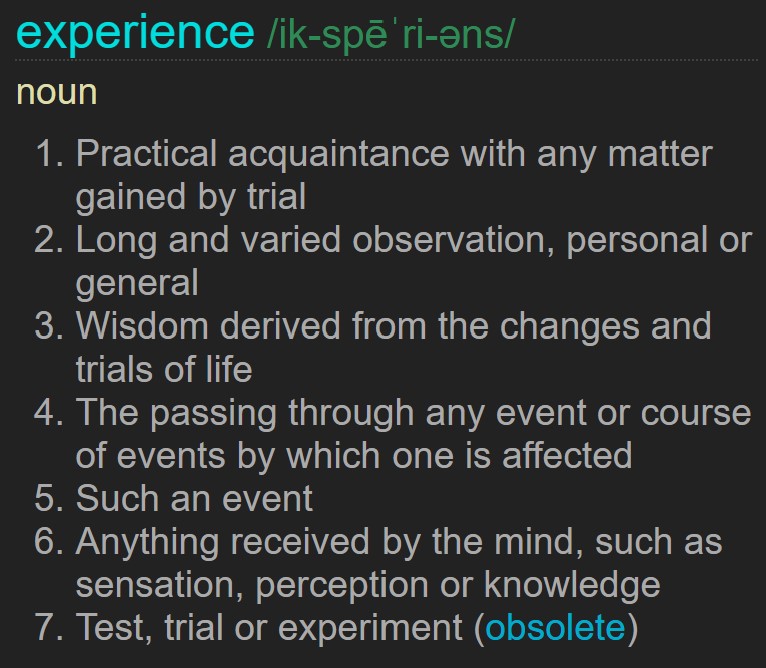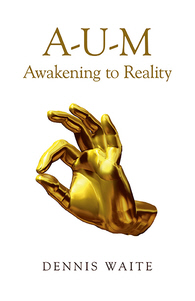Here are the definitions for the word ‘experience’ in Chamber’s dictionary:


*** Read Part 12 ***
अमात्रश्चतुर्थोऽव्यवहार्यः प्रपञ्चोपशमः शिवोऽअद्वैत
एवमोङ्कार।
आत्मैव संविशत्यात्मनाऽऽअत्मनं य एवं वेद य एवं वेद ॥ १२॥
amAtrashchaturtho.avyavahAryaH prapa~nchopashamaH shivo.Advaita
evamo~NkAra .
Atmaiva saMvishatyAtmanA.a.AtmanaM ya evaM veda ya evaM veda || 12 ||
chaturtha – The fourth (aspect)
o~NkAra – of the syllable OM
amAtra – (has) no parts (i.e. is limitless);
avyavahArya – (is) transcendental (not at the level of empirical transactions),
prap~nchopashamam – has no phenomenal existence,
shivaH – is ‘all bliss’
Advaita – (and) non-dual.
Atma eva – (It is therefore) verily the Self.
ya evaM veda – Whosoever knows this
saMvishati atAnaM – merges his self
AtmanA – into the Self.
*** Read Part 8 ***
सोऽयमात्माऽध्यक्षरमोङ्कारोऽधिमात्रं पादा मात्र मात्राश्च पादा अकार उकारो मकार इति ॥ ८ ॥
so.ayamAtmA.adhyakSharamo~NkAro.adhimAtraM pAdA mAtra mAtrAshcha pAdA akAra ukAro makAra iti || 8 ||
saH ayam AtmA – this same AtmA (just described in the 7th mantra)
adhyakSharam – adhi – concerning (i.e. from the standpoint of) – akShara – the syllables
o~NkAra – is OM.
(adhi literally means ‘making it the basis’. Shankara says that the previous mantras have concentrated on the abhidheya meaning ‘that which is being spoken of’, i.e. the thing named or denoted. OM, therefore, is effectively the abhidhAna – name or appellation. What is meant is that Atman is equated to OM in the linguistic sense.)
adhimAtraM – from the standpoint of the mAtra-s, i.e. the individual parts of OM, (note that the literal meaning of mAtra is measure; the symbolism of this will become clearer with the 10th mantra)
pAdA mAtra – the (four) aspects (of the Self) are the (four) mAtra-s
mAtrAshcha pAdA – and the letters are the aspects.
akAra ukAro makAra iti – In this manner, (the letters are) a, u and m.
This Atma can be equated to OM. The aspects of the Self are the parts of OM and the parts of OM are the aspects. The letters constituting OM are ‘a’, ‘u’ and ‘m’.
Continue reading*** Read Part 7 ***
नान्तःप्रज्ञं न बहिष्प्रज्ञं नोभयतःप्रज्ञं न प्रज्ञानघनं न प्रज्ञं नाप्रज्ञम् ।अदृष्टमव्यवहार्यमग्राह्यमलक्षणमचिन्त्यमव्यपदेश्यमेकात्मप्रत्ययसारं प्रपञ्चोपशमं शान्तं शिवमाद्वैतं चतुर्थं मन्यन्ते स आत्मा स विज्ञेयः ॥ ७ ॥
nAntaHpraj~naM na bahiShpraj~naM nobhayataHpraj~naM na praj~nAnaghanaM na praj~naM nApraj~nam |adRRiShTamavyavahAryamagrAhyamalakShaNamachintyamavyapadeshyamekAtmapratyayasAraM prapa~nchopashamaM shAntaM shivamAdvaitaM chaturthaM manyante sa AtmA sa vij~neyaH || 7 ||
This (consciousness) is known as the ‘fourth’. (It is) neither (the knower of) the internal (world), nor the external. Neither (is it the knower of) both. (And it is) not (just) a ‘mass’ of consciousness. (It is) not consciousness (in the empirical sense of conscious ‘of’) nor (is it) unconsciousness. (It is) imperceptible, transaction-less, not ‘graspable’, un-inferable, unthinkable, and indescribable. (It is) the essential ‘I’-experience. (It is) the negation of the experience of all plurality of the universe. (It is) pure, tranquility, and non-dual. This is the Self. This is to be understood.
This 7th mantra is possibly the single most important mantra in the whole of the Vedic scriptures; it attempts to ‘describe’ the nature of absolute reality, knowing that such description is intrinsically impossible.
Continue readingQ: Do the Upaniṣads talk about or mention mithyā? If not, why not, when Advaita seems to speak so much about it?
A: The absolute ‘bottom line’ of Advaita is as expressed by Māṇḍūkya Up. and Gauḍapāda’s kārikā-s, namely that there is no creation, no one has ever been born etc. Māṇḍūkya 7 is the final word on the matter:
“This (consciousness) is known as the ‘fourth’. (It is) neither (the knower of) the internal (world), nor the external. Neither (is it the knower of) both. (And it is) not (just) a ‘mass’ of consciousness. (It is) not consciousness (in the empirical sense of conscious ‘of’) nor (is it) unconsciousness. (It is) imperceptible, transaction-less, not ‘graspable’, un-inferable, unthinkable, and indescribable. (It is) the essential ‘I’-experience. (It is) the negation of the experience of all plurality of the universe. (It is) pure, tranquility, and non-dual. This is the Self. This is to be understood.”
Consequently, anything in experience (i.e. dualistic) cannot be real. Yet we DO experience the world. Therefore, it has to be mithyā. No need to specifically talk about it. Gaudapada does, in fact, in Chapter 2, which is called ‘Vaitathya Prakaraṇa’. Vaitathya is essentially a synonym for mithyā. (My book ‘A-U-M’ is all about this – https://www.advaita.org.uk/extracts/a_u_m_unreal.html).
Ṥaṅkara also talks about it in BSB 1.4.19; 2.1.14; bhāṣya on Mand. Up. 7; Gaud. kārikā 4.9 and Vivekacūḍāmaṇi 194 -5 (ish).
The distinction between paramārtha and vyavahāra is also effectively another way of talking about mithyā. Vyavahāra is ‘appearance’, whose substantive reality is actually Brahman. Every discussion about ‘name and form’ as opposed to reality is about mithyā, whether or not the word is used.
I have just started reading the massive commentary on the mANDUkya, Gaudapada kArikA-s and Shankara bhAShya (if it was Shankara) by Divyaj~nAna Sarojini VaradarAjan, so I thought it might be appropriate to post my own translation and commentary on the Upanishad itself from ‘A-U-M’.
The VaradarAjan book is in two volumes and, as far as I am aware, is only available from Exotic India at £65 to post to the UK. Only 500 copies were printed and these may sell out quickly as her Upanishad commentaries are unparalleled.
My own book ‘A-U-M: Awakening to Reality’ is a ‘by topic’ rather than verse by verse commentary, although it does cover all of the material. The specific translation and commentary on the 12 verses of the Upanishad itself are relegated to an Appendix, since the material is rather ‘dense’, and the tone less ‘conversational’ than the main body of the book. It is available from Amazon:
Book ($34.95): Buy from Amazon US; Kindle ($16.49): Buy from Amazon US
Book (£20.99): Buy from Amazon UK; Kindle (£6.99): Buy from Amazon UK
This series will post the whole of Appendix 1 of ‘A-U-M’ and, in general, each post will cover one verse of the Upanishad. This first post, however, covers the shAnti pATha – the traditional prayer at the beginning of an Upanishad – and Shankara’s introduction.
Continue readingQ: My question is one I can’t seem to clarify through any book, teacher or teaching:
How do we know that the brain isn’t responsible for consciousness? While we can observe mind with all of it’s contents as objects and then say we cannot be that which we observe, how can we be sure that there is not just some part of the brain which does the observing that is giving us this ability to watch thought? How does Vedanta address this? How can we know that the brain isn’t simply the one observing all phenomena?
Side note: I lost consciousness once due to a fall and blacked out, and all I can say is that there was complete absence of being and no one there to be aware of the non-beingness. No observer nor observed. Beyond no-thing. Absolutely no experience beyond the concept of the word. Continue reading
 What exactly happens when a person is enlightened or ‘gains mokSha’? A popular, although somewhat incomprehensible, belief is that the world somehow ‘disappears’; that, for the j~nAnI, there simply is no longer any duality. Quite how the j~nAnI (apparently) continues to eat, drink and converse is not adequately explained by those who hold such a view. But Gaudapada approaches it from a different and even more dramatic angle.
What exactly happens when a person is enlightened or ‘gains mokSha’? A popular, although somewhat incomprehensible, belief is that the world somehow ‘disappears’; that, for the j~nAnI, there simply is no longer any duality. Quite how the j~nAnI (apparently) continues to eat, drink and converse is not adequately explained by those who hold such a view. But Gaudapada approaches it from a different and even more dramatic angle.
Prior to my enlightenment, I make the mistake of identifying myself with the body-mind, believing myself to be a separate entity. This is the result of my Self-ignorance – not realizing that I am the unlimited Atman. Gaudapada says that this ignorance is beginningless (anAdi) (K1.16). At the dawn of Self-knowledge, I recognize that I am not the waker, dreamer or deep-sleeper but the non-dual turIya.
As to whether or not the world then disappears, Gaudapada effectively asks: how can it disappear when it didn’t exist to begin with? “If the visible world actually existed, there is no doubt that it might stop (i.e. disappear) (as soon as j~nAna was gained). (But) this (apparent) duality is merely mAyA (and) the absolute truth is non-dual.” (K1.17) Continue reading
The recent post by Ramesam – Ignorance goes, but mAyA remains? – continues to draw discussion. It has now reached nearly 50 comments! Ramesam’s last comment kindly referred to Gaudapada’s kArikA 1.17 and, looking this up in my book ‘A-U-M: Awakening to Reality’, I found that I had put together a very useful post to the Advaitin E-group back in 2009. Accordingly, it seems appropriate to post this here and, since it is longer than a simple comment, I am starting a new thread.
*****
A favorite topic on the Advaitin discussion group (http://groups.yahoo.com/group/Advaitin/) (where I am one of the moderators) has been what exactly happens when a person is enlightened or ‘gains mokSha’. A popular, although somewhat incomprehensible, belief is that the world somehow ‘disappears’; that, for the j~nAnI, there simply is no longer any duality. Quite how the j~nAnI (apparently) continues to eat, drink and converse is not adequately explained by those who hold such a view. But Gaudapada approaches it from a different and even more dramatic angle. Continue reading
Q: When the jIva removes the ignorance of his real nature, and realizes Atman is his Real unchanging Self, if the body dissolves, what happens afterwards?
If there is no further birth, do we then remain as Absolute, without name and form, without knowing anything other than pure Self? Is it like space all being uniform without any form? Is there nothing that is known? Surely it doesn’t remain In an absolute ‘stateless state’ of no Knowing?
A: There have been a couple of questions around this before – see http://www.advaita.org.uk/discourses/q_and_a/q_and_a44.htm#q263 for example.
Your question is based on a misunderstanding. At the empirical level, there is indeed a ‘person’ who may or may not become enlightened. If he/she does gain Self-knowledge, then clearly the outlook of the person for the remainder of his/her ‘life’ is going to be different.